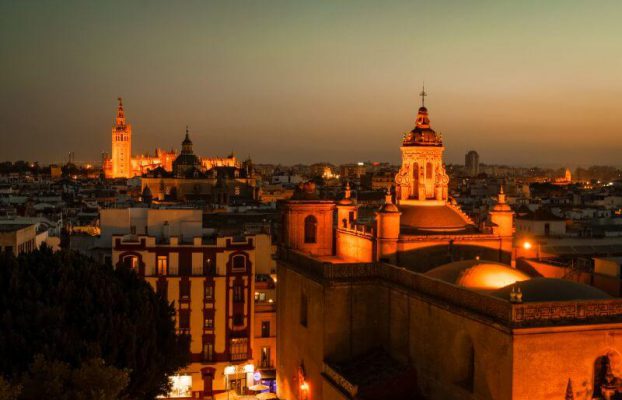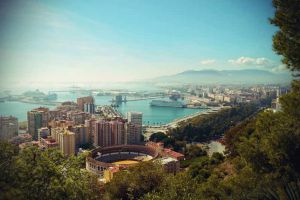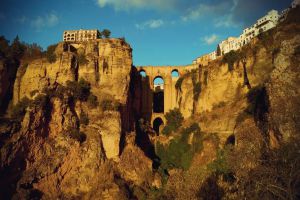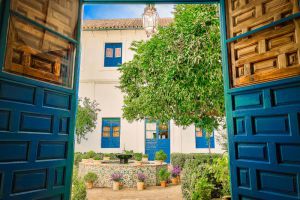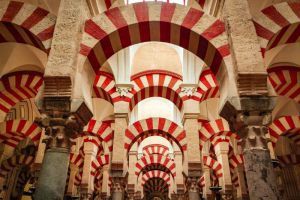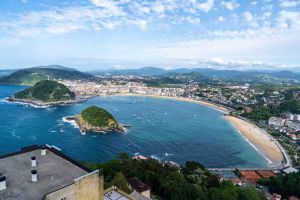Fiery flamenco, breathtaking architecture with Moorish influences and impressive royal gardens a la Game of Thrones: Seville’s sights are fantastic and the city itself is one of the most beautiful in Europe. Even for just a weekend, it’s worth a trip. In this article, however, I will give you enough Seville tips to fill a whole 4 days. The choice is entirely up to you.
For the following 15 tips, I asked a few Spanish colleagues who lived in Seville for several years. So you will also find a few things here that are not necessarily the first recommendation in the travel guide.
If you’re still not sure whether Seville is right for you, then watch the following video first to see the diversity and beauty of the city for yourself.
Journey to Seville
Sevilla does not have a particularly large airport. Only a few airlines fly directly here. But you can easily fly to neighboring Jerez de la Frontera (XRY) and take the train from there to Seville.
The train ticket Jerez – Seville costs €11.20 and the journey takes about 1 hour. There is a stop right at the airport, but the train doesn’t always stop here. However, even if you are late, you can travel in the other direction to the city center of Jerez for €1.80 and then take the express train from there. By cab this costs around €15.
Best time to visit Seville
The southwest of Europe, where Seville is located, is one of the warmest regions on the continent – even in winter. From November onwards, however, the likelihood of rain increases here too.
So it’s a very good idea to travel to Seville in October. The probability of rain is somewhat higher than in June and July, but at 30 degrees you still have summer temperatures. In addition, there are relatively few tourists in October and you will be able to take photos of the sights without older people with sandals and fanny packs walking in front of your lens. The same also applies to April.
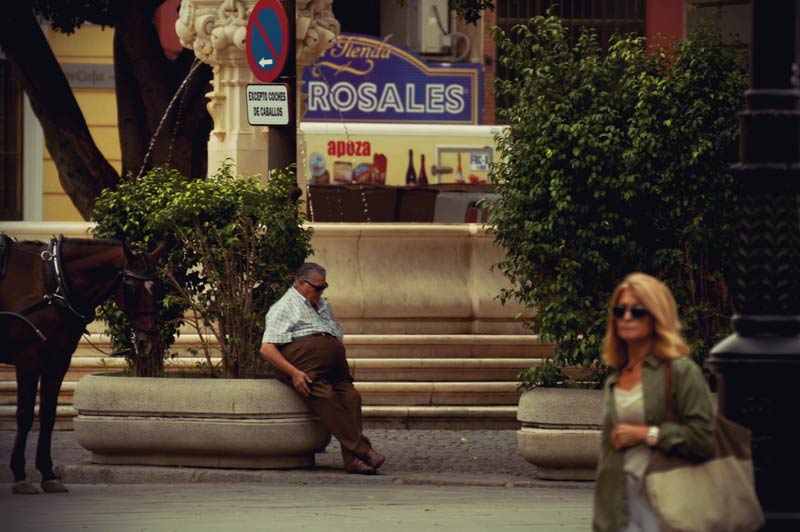
Accommodation in Seville
You should definitely look for a place to sleep in the middle of the old town, because then you can explore everything on foot without any problems and are also quickly at the train station.
I can recommend the Santa Cruz district. Santa Cruz is perfect for simply wandering through the alleyways and letting yourself drift. The area around Alameda de Hercules was very practical for me, because you can go out here in the evening and then get home again quickly afterwards.
The Hotel Doña María is also a very good choice. It is located right next to Seville Cathedral and perfectly embodies the charm of this city. You can find more information about a special feature of this hotel under point 8 of this article.
All of the following tips can also be found here on the map:
Enough of the introductory words. Let’s get straight to the best sights in Seville:
1. Wander through old mansions and villas
In addition to several cathedrals and churches, there are also several historic mansions and villas throughout the city. For me, visiting these picturesque palaces was one of the highlights of my city trip, as you feel like you’ve been transported back to a bygone era. The colorful azulejos (= tiles), the works of art on display and the idyllic gardens kissed by sunlight create a certain Game of Thrones atmosphere.
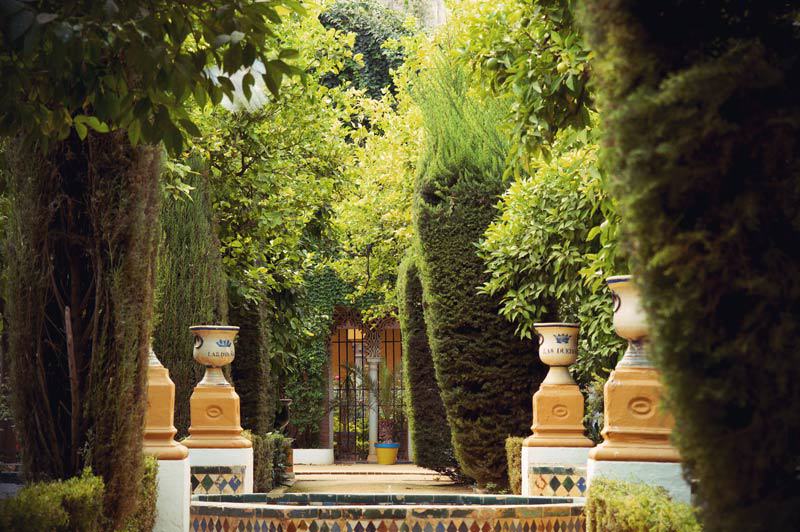
In total, I visited three of the mansions:
Palacio de Las Duenas
The Palacio de Las Duenas was my absolute favorite. I was particularly fascinated by the gardens, but also by the exhibits in the individual rooms of the house, which was built in the 16th century.
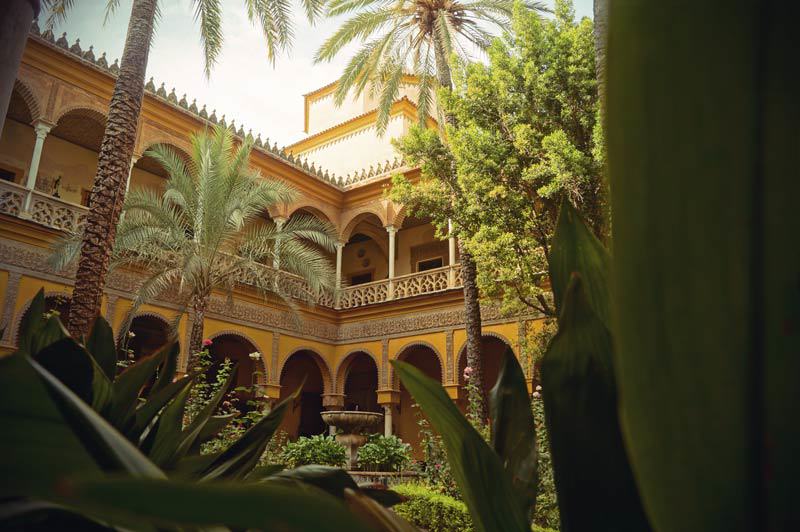
Admission costs €8. You can also get an audio guide for €2 (but not in German). You shouldn’t arrive too late, as the museum is only open until 18:00 in October. Allow about 2 hours for the tour. Of course, it can also be done more quickly if you are not so keen on discovering details.
Casa de Pilatos
The Casa de Pilatos is also worth a visit. It was built in the 15th century and has many influences from different eras, such as the Renaissance, Mudéjar (Mudéjares were the Spanish Muslims) and Romanticism.
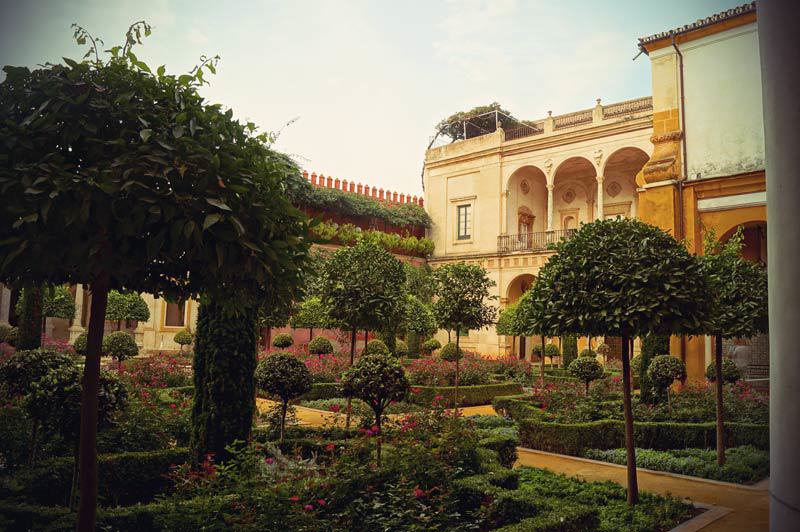
Free admission for EU citizens. There are also audio guides. However, you can only enter the upper floor with a guided tour. This costs €10.
Palace of the Countess of Lebrija
This house is not so well known to most tourists, although it is located in the middle of the city and contains many archaeological finds, impressive mosaics and decorative elements from the Arab world. When I visited during the week, I was the only guest and was able to enjoy the tranquillity of the property’s quiet courtyards.
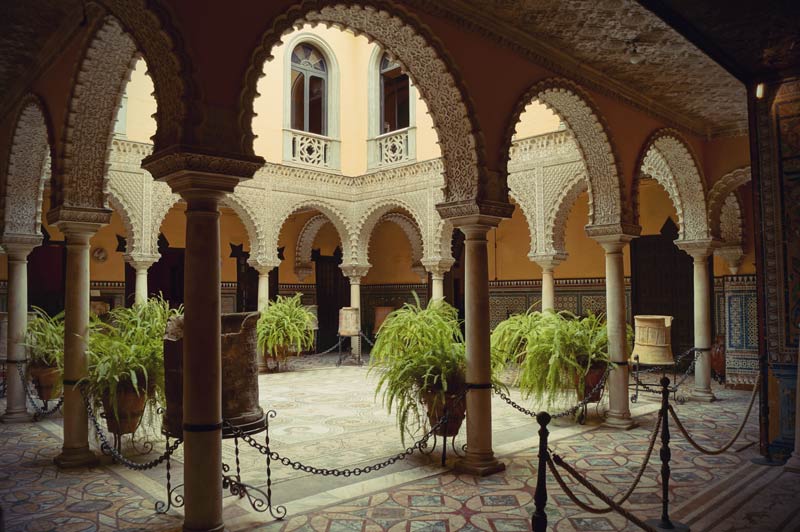
Admission for the lower corridor only costs €6. For €9 you can also visit the upper corridor, but only with one of the guided tours that take place several times a day at certain times.
2. Visit the royal palace
The royal Alcázar of Seville should be at the top of your to-do list in Seville. The history of this medieval complex dates back to Moorish times. The architecture of the buildings is correspondingly impressive. The crowning glory is the huge adjoining park with numerous rippling water features, peacocks strutting across the meadows and labyrinth-like hedges.
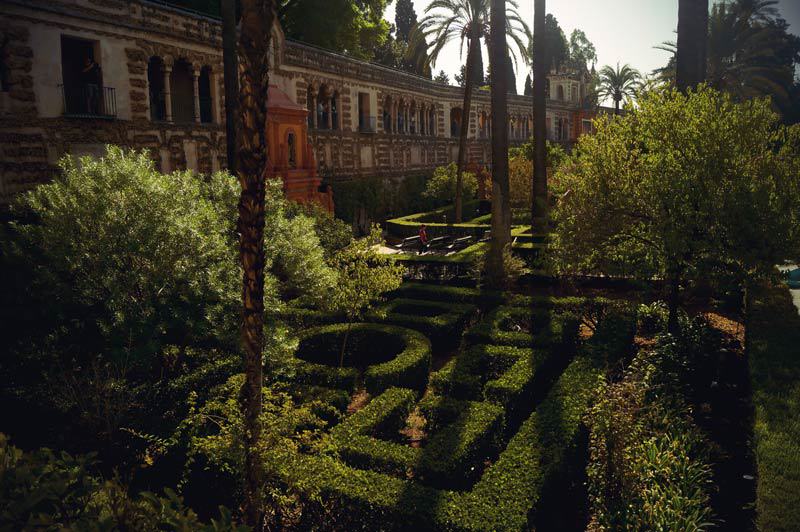
It’s mid-October at 10:00 in the morning. The oranges are still green. They can only be harvested again next year. But the sun shines uninterruptedly like in summer and it smells sweetly of blossoms like in spring. I find myself in the magnificent Alcázar of Seville and enjoy the pleasant warmth, away from the groups of tourists. The pleasant silence in the park is only interrupted by the occasional twittering of birds and the trickling of fountain water – I almost feel like I’m in a fairy tale from the Arabian Nights. It’s easy to endure here.
from my travel notes

So it’s no wonder that the palace is also the residence of the Spanish king when he visits the city. The palace complex was also the filming location for some “Game of Thrones” episodes. Admission costs €14.50. If you also want to go into the royal rooms, then €20 You can also buy the tickets beforehand online, but you must specify the exact time you want to come.
If you are in Seville on a Monday, admission to the Alcázar is even free.
Would you like to see the Alcázar before most of the other tourists so that you can take pictures of the interior without the crowds? Then an Alcázar VIP entrance ticket is a good idea. It gets you into the palace an hour before it opens and also includes a guide with a tour. Tickets are of course limited per day. So you should be quick if you want to have the Alcázar almost all to yourself.
The Alcázar opens daily from 9:30 am. However, there is already a huge queue in the morning. I was there on a Sunday at 9:15 am and had to wait around 30 minutes after opening, so 45 minutes in total. But no problem – with headphones and Spotify. It might be better if you visit the palace during the week. If you’ve already bought tickets online beforehand, you’ll get in quicker in a second queue. However, guided tours are admitted first.
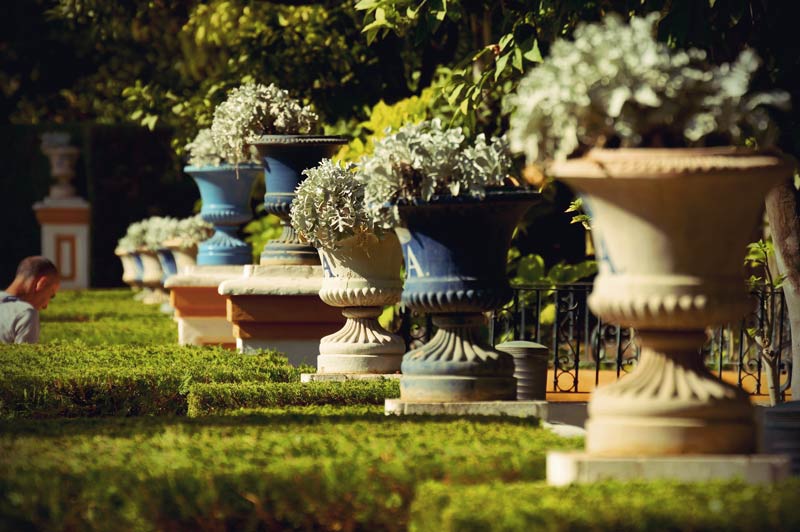
The guided tours all run through the palace first thing in the morning. In general, it will be difficult not to have tourists somewhere in the pictures of the inner courtyards of the palace. If you don’t get the VIP ticket, it’s best to walk all the way through to the gardens first, where it’s still very empty at this time of day, and chill out there for a while. You can also see the rest later.
3. Cool your feet at the Plaza de España
You shouldn’t miss out on one of the most beautiful squares in Europe: The Plaza de España.
The semi-circular building around the square was only built in 1929 for the Ibo-American Exposition, but it is in no way inferior to the rest of the city in terms of architectural beauty. There is a fountain in the center where you can cool your feet on a hot day. You can also take a paddle boat along the river.
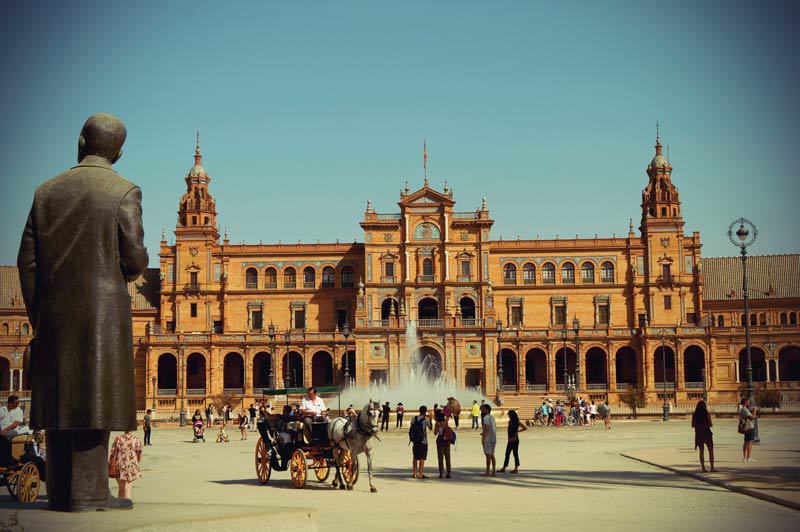
The towers of the building are freely accessible. However, I found the ornaments at the foot of the walls particularly fascinating. These show all the regions of Spain, each decorated with intricately drawn ceramics.
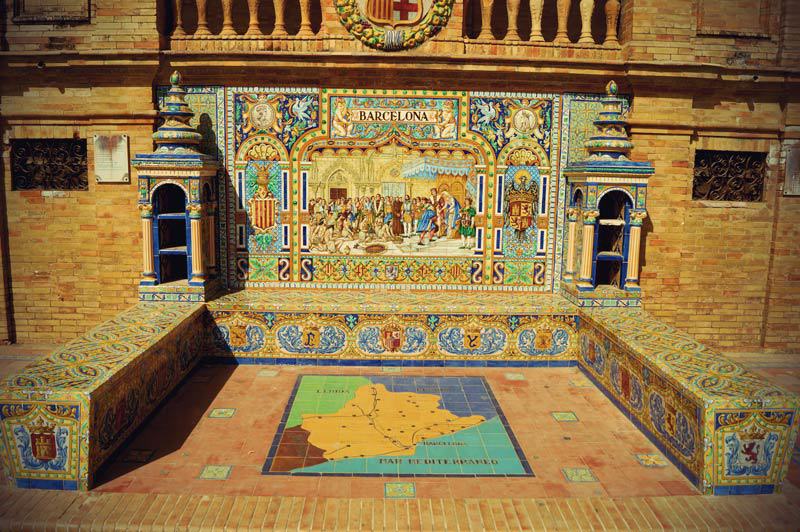
Some scenes in the film “Star Wars: Episode II – Attack of the Clones” were also shot here.
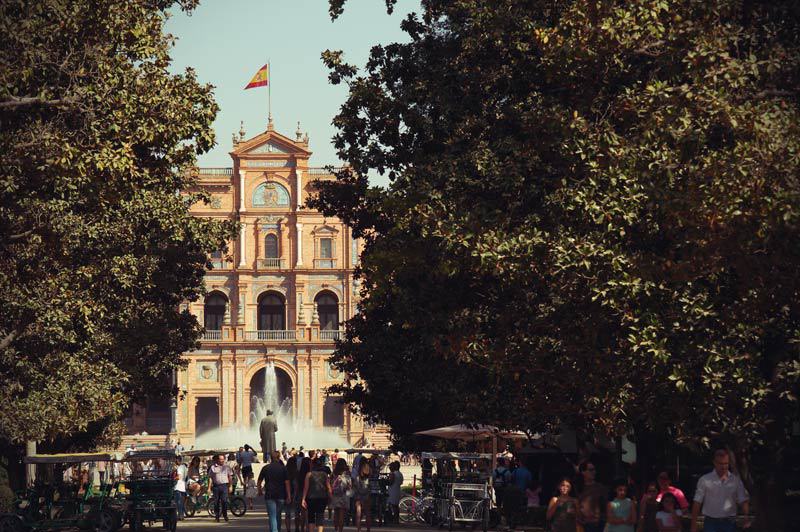
4. Discover Seville by night
You will probably see most of the sights in Seville during the day. But try to see at least 2 or 3 of them at night when everything is brightly lit.
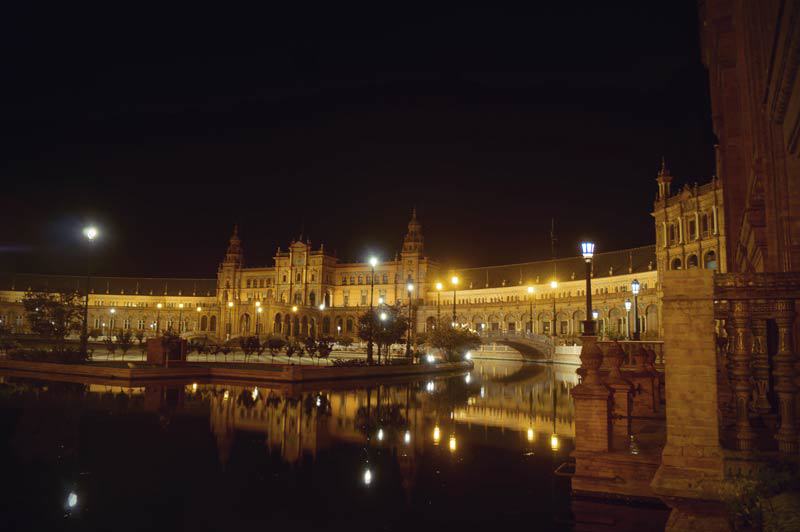
I found the Plaza de España mentioned in point 3 particularly beautiful. It has a completely different atmosphere than during the day – the towers are reflected in the water and it is much quieter without all the tourists. An almost melancholy atmosphere fills the square. Only the remaining castanet vendors still make a little noise here and there.
5. Eat tapas in one of the best restaurants in town
Wandering through the city and not passing a tapas bar is actually bordering on the impossible.
According to my Spanish colleagues (and they know where to find good tapas), you should definitely visit the Tapasbar Eslava. Both tourists and, above all, locals come here. During my visit, there was a whole wedding party here to drink and eat. I was lucky to find a seat at all in this rather small restaurant.
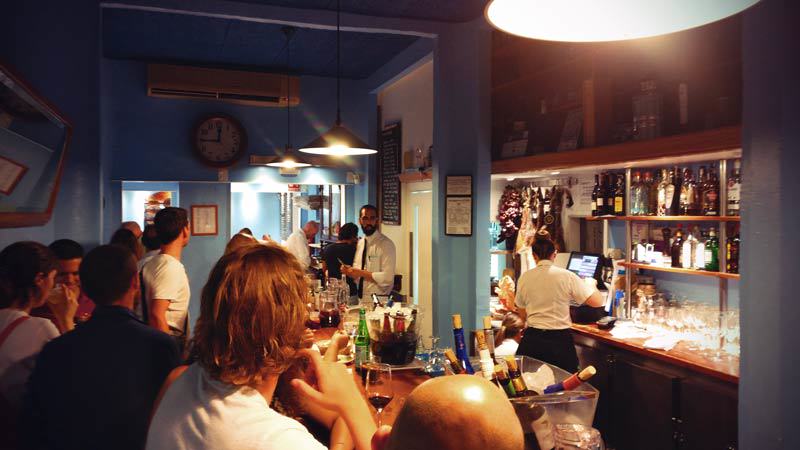
Culinary delights on offer here are a mix of modern and traditional Andalusian cuisine. I myself found the smoked salmon absolutely delicious. Incidentally, the bar has two floors. There is also a terrace on the upper floor.
You can also discover Seville’s tapas and food secrets on a tapas tour or even a cooking class with local chefs:
- Tapas Crawl
- Tapas, taverns and history on foot
- Tapas tour with traditional flamenco show
- Spanish cooking course and market by Triana
6. Look over the rooftops of Seville from the Metropol Parasol
The Metropol Parasol is a modern wooden construction by German architect Jürgen Mayer H. On the platform below is a rather unspectacular square where kids skateboard and rollerblade during the day.
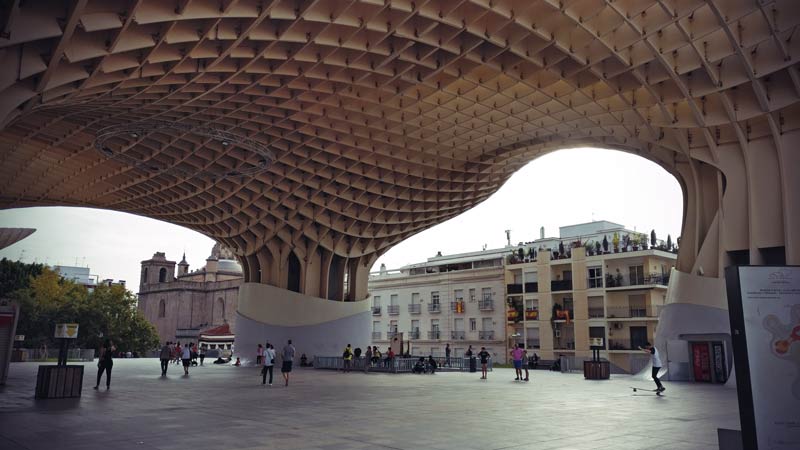
The real highlight, however, is the roof, which you can climb up to for €3. Along the circular route, you have a fantastic panoramic view of the whole city.
During the day, there is a long queue here, especially at weekends. But I would advise you to come here in the evening anyway. Firstly, you won’t have to wait so long and secondly, you can watch the sunset and see the city slowly turn into a sea of warm lights.
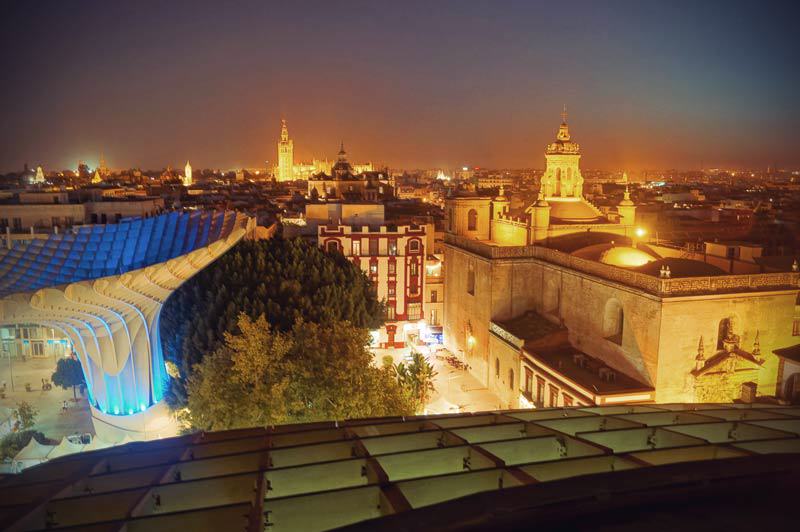
7. Explore the old town in the early morning
While Seville’s old town is teeming with people during the day, it is idyllically quiet around 8:00 in the morning, when most Sevillians are still asleep.
Only the sound of bells echoes through the empty streets. You should experience this at least once a day.
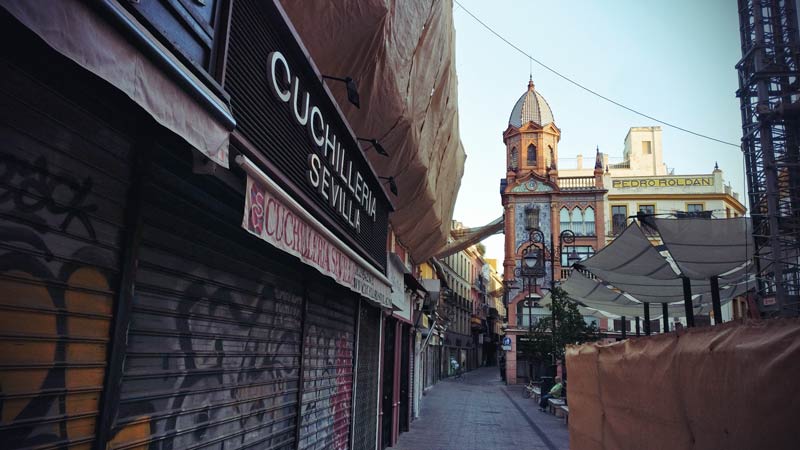
There are many beautiful places that you can easily discover without a plan. But you should still head for one: the Plaza del Cabildo, which is somewhat hidden between houses.
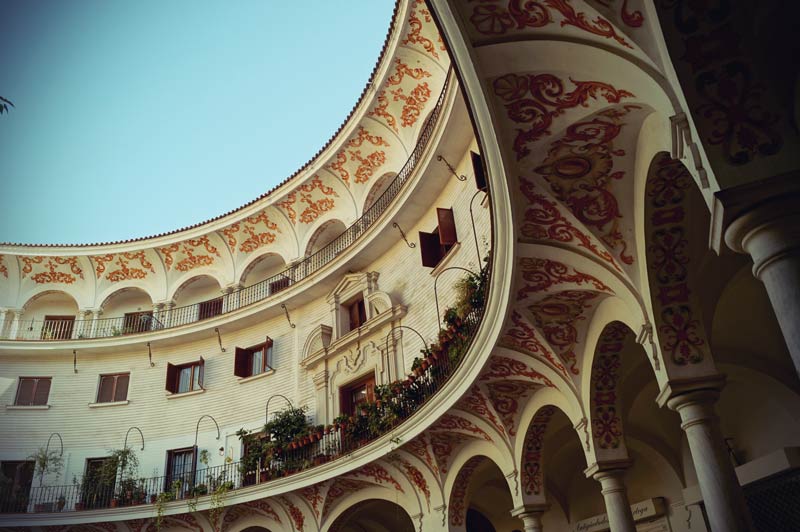
8. Relax with a cocktail at a rooftop bar with exclusive views of La Giralda
Relaxing jazz music, a warm summer breeze blowing over your skin in October and a fresh, minty mojito. But the best part: all with a view of the brightly lit La Giralda.
Sounds good?
Then simply visit the rooftop terrace of the Hotel Dona Maria. Even if you are not a guest of the hotel, you have access via the neighboring Bar17.

Jazz music, a cocktail and this view: What more could you want?
9. Let yourself be enchanted by the magic of flamenco
Flamenco is a fiery, emotionally charged style of music that goes way back in time and originates from Andalusia. It includes guitar music, singing but also the famous baile (= dance) with the unmistakable castanets.
There are numerous opportunities to discover flamenco culture in Seville. You can get infected by flamenco, especially in the evenings during intense shows.
The best addresses for this are:
- Museo del Baile Flamenco
- Los Gallos
- El Palacio Andaluz with optional dinner
- at the “Teatro Flamenco Triana”
- Casa de la Guitarra
- Casa de la Memoria
- Tablao el Arenal
If you want to get active yourself, then you should book a flamenco dance lesson for beginners with a local teacher.
If the shows are too expensive for you, just keep your eyes open during the day. Often street performers just perform in squares, play the guitar or beautiful Spanish women dance wildly through the streets. Many bars also host spontaneous flamenco sessions in the evening (see point 13).
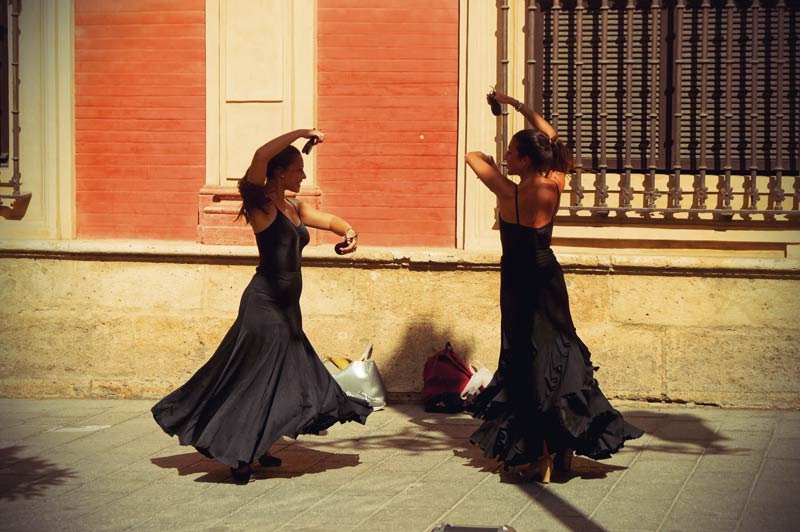
10. Explore the city by bike
Sevilla has one of the largest old towns in Europe. It takes a while to walk around it once. You’ll be quicker by bike. You can also cycle along both sides of the idyllic riverbank, past the Torre del Oro, and visit spots outside the city center to escape the hustle and bustle of the city.
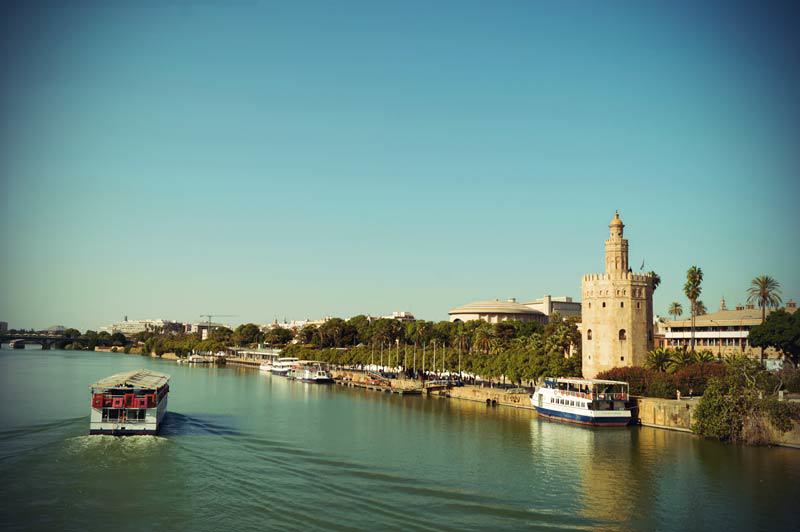
The Alamillo Park in the north, the somewhat strange-looking Huevo de Colón and the site of the former World Expo (Expo 92) are well worth a visit. The latter still has some remaining sculptures that you can simply cycle past, such as the Esfera Bioclimática.
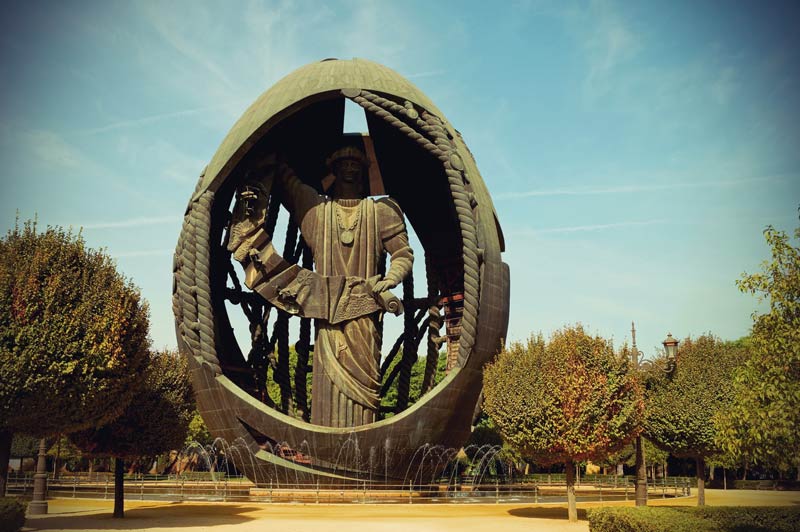
Where to rent a bike?
There are many providers all over the city center. I myself can recommend BICI4CITY near the Alameda de Hercules. Here you can get a bike for around €10 to €15 per day and you can choose the model yourself. However, there are many other providers, including public ones such as SEVici. SEVici’s 2,500 or so bikes are located all over the city and you can take them from their stations at any time with a service card. The card is available from vending machines and is valid for 7 days.
If that’s too exhausting for you, there are also mobile tours with other cool companions through the city. Take a look here:
- Sevilla Segway Tour
- Sevilla electric bike tour
- Electric scooter tour
- From Seville: Andalusian horseback riding trip
11. Discover modern art in an old monastery
An old monastery and modern art don’t really go together at first. But they do in Seville. Next to the Monestario de La Cartuja, where Christopher Columbus was recorded in the 16th century, is the Museum of Modern Art, which you can visit for just €1.8. However, it is closed on Mondays.
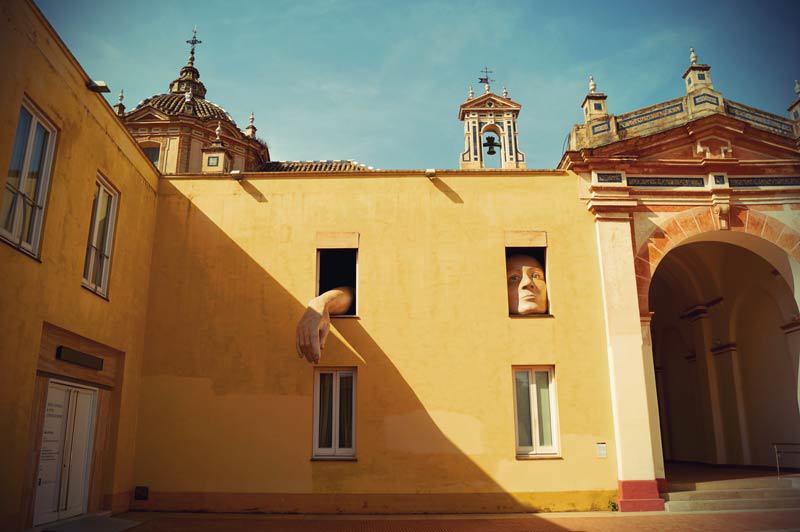
12. Explore the Triana district
Sevilla has more to offer than its huge old town. Directly west of the center, on the other bank of the river Guadalquivir lies the Barrio Triana, which you should also explore.
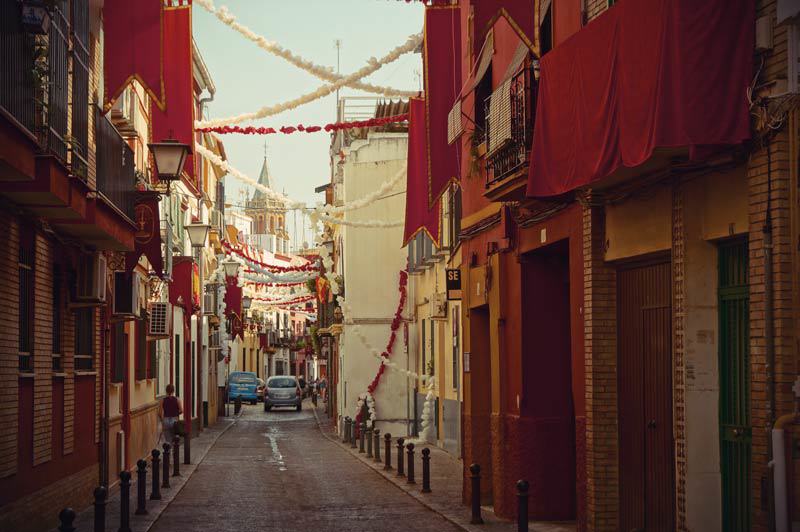
Triana impresses with its narrow streets decorated with garlands and azulejos, the many Spanish churches and the lively flamenco culture. The most beautiful part is opposite the Puente de Isabel II bridge (also known as Puente de Triana). There are many restaurants, tapas bars and also some markets here.
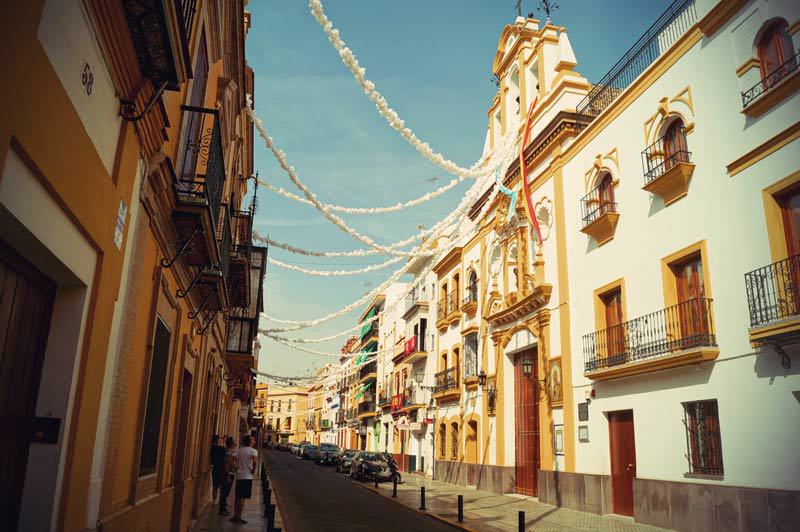
13. Discover the alternative party scene at Almeda de Hercules
Legend has it that the Greek hero Heracles (also known as Hercules) founded the city of Seville. The Marketplace Almeda de Hercules is a reminder of this. However, it was only built in the 16th century. Two mighty columns from this period still stand at the entrance to the square.
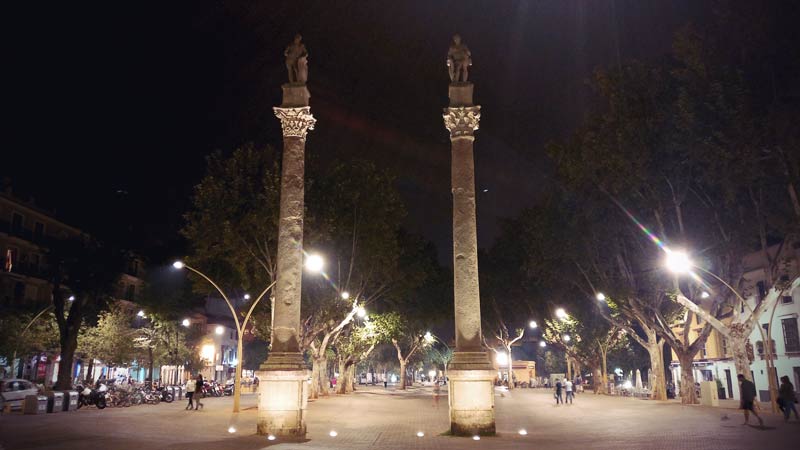
Other than that, the area around the Almeda de Hercules is now a popular, alternative nightlife center. The two streets are lined with one tapas bar after another and there is a lot of drinking, dancing and guitar playing – even during the week.
You can also have a great breakfast here or just sit down during the day and enjoy a bocadillo (Spanish sandwich) with a coffee. I can recommend the Las Columnas for this. For a delicious dinner, there is no way around Casa Paco.
14. Enjoy a free screening at the Palacio Marqueses de la Algaba
During the day, you can visit the historic Palacio Marqueses de la Algaba for free. The palace dates back to the Mudejar period and is architecturally very valuable. Inside there is an interesting exhibition with relics from the Moorish period back to the 15th century.
But it gets really exciting here in the evening. In summer, until September 24, many different theater performances, flamenco performances and concerts take place during the so-called summer nights. Admission is also free, but only as many people are allowed in as there is room.
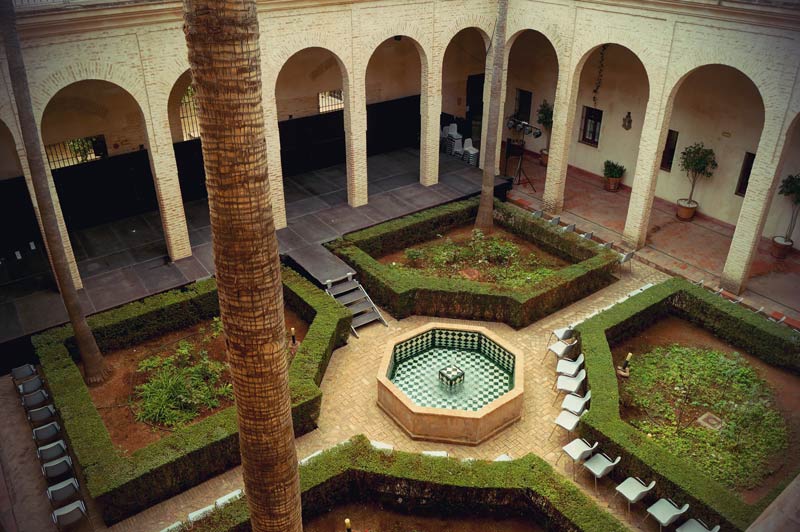
15. Climb the largest Gothic cathedral in the world
The Cathedral of Seville is one of the most famous landmarks of the city. Even from the plane, you can spot “La Giralda”, the cathedral’s bell tower. It dates back to the 12th century and you can also climb it to enjoy the view over the rooftops of the city
.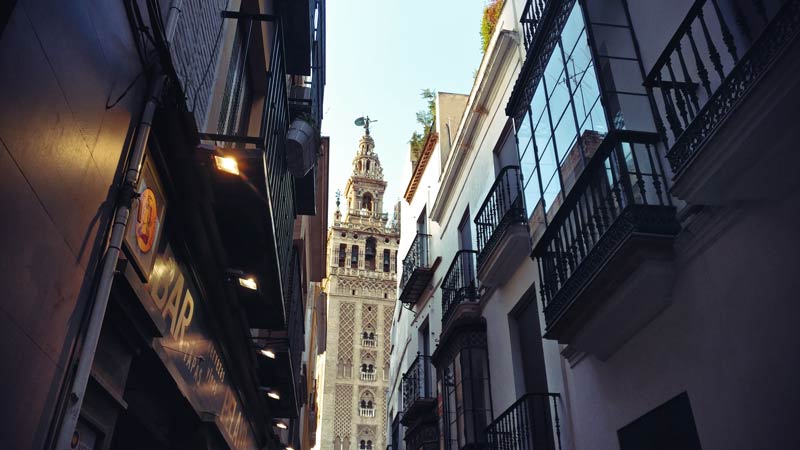
But that’s not the only reason why the €17 entrance fee is worth it. The cathedral itself, with its mixture of different architectural styles, is very impressive.
The Main Altar (Altar Mayor), to which only the rich and powerful used to have access, is particularly special. At 2 m, the figures on the top level are almost twice as tall as those on the lowest level. To the viewer, however, this makes them appear the same size.
In addition, you can visit the sarcophagus of Christopher Columbus in the cathedral.
Tickets for the cathedral and the bell tower, where you don’t have to queue, are available online here for €17.50.
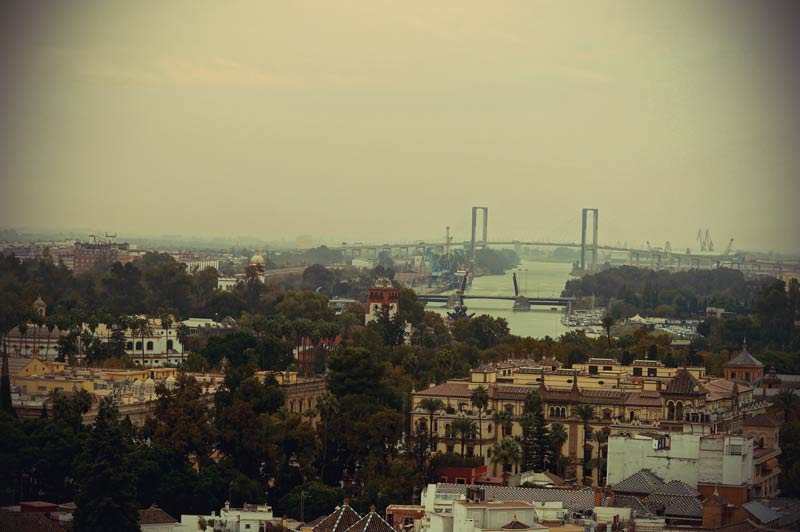
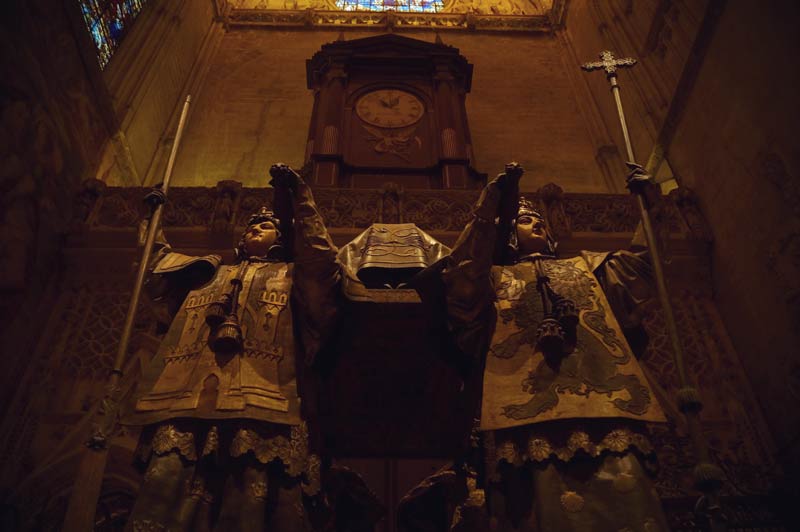
As you can see, Seville is well worth a visit. What other cool places should you visit here? Leave a comment with your recommendations.
Tools & services I recommend for your trip:*
📶 Flexible and affordable mobile Internet worldwide
🚁 My drone for aerial photography
🚗 Find and compare cheap rental cars
🎟 Find and book cool activities
🔒 Secure Internet connection with NordVPN
*Note: These links are affiliate links. If you book through them, I will receive a small commission without it being more expensive for you. A purchase from you via these links helps me to continue offering free content without annoying ads on this website. Thank you for your support! I really appreciate it!

